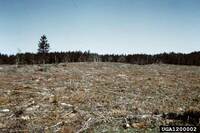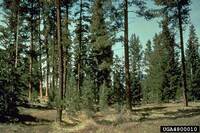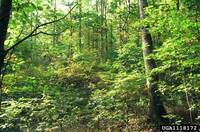Selection forestry is best for the environment.
R S Troup, who wrote a standard text on silvicultural systems, observed in 1928 that:
From the aesthetic point of view those systems which maintain a continuous forest cover, and particularly the selection system, are preferable to those in which periodical clearings are made, such as the clearï¾cutting and simple coppice systems. In Europe a belt of forest treated under the selection system is often maintained round the outskirts of towns and villages (Troup 1928: 179).
Despite this comment in such an influential book, it remains the case, as Helliwell pointed out in 1982, that 'In Britain, the subject of visual amenity within the forest seems to have received little attention, with the main emphasis being on the effects of our relatively fragmentary forests in the wider landscape' (Helliwell, 1982). The effect of different silvicultural systems on the forest interior is a subject of great importance: alternative systems have very different effects on plants, animals and men.
The sharpest contrast, as Troup observes, is between selection forestry and clearï¾cutting. Under the selection system, 'felling and regeneration are not confined to certain parts of the area but are distributed all over it, the fellings consisting of the removal of single trees or groups of trees scattered throughout the forest' (Troup 1928: 179). Selection forestry produces a full range of tree sizes and considerable diversity of plant and animal species. Under the clearï¾cutting system large areas of forest are 'clear felled and regenerated, most frequently by artificial means but sometimes naturally' (Troup 1928: 4). Its modern history starts in Germany at the beginning of the nineteenth century (Troup 1928: 18). The system became popular because it requires less skill to implement and affords maximum economy in the mechanisation of felling and extraction. The disadvantage of clear cutting is that the forest is devastated, the ecosystem disrupted and the soil exposed to erosion [Fig 8.19]. The new trees look more like an agricultural crop than a forest ï¾ until they are ready to be felled. The system has fallen from favour in Germany, America and other developed countries. It survives in Britain.
There are a number of variations on the two main silvicultural systems. Helliwell has identified eight separate systems and gives an analysis of their advantages and disadvantages (Helliwell 1982: 48).
Table: Comparison of the main silvicultural systems (by D.R.Helliwell)
Clearï¾felling Shelterwood Group Selection Selection
Pure Mixed Pure Mixed Pure Mixed Pure Mixed
Soil
-1
-1
-1
-1
Flora
-2 -1
-2 -1
+1
+2
Fauna
-2 -1
-1
+2
+2
Amenity
-2 -1
-1
+1
+1
Windthrow
+1
-2 -1
-1 +1
+1
Pathology
-2 -1
-1
-1
Costs
+2 +2
+1
-1
-1 -2
The table reinforces Troup's point that clearï¾felling is economically best but environmentally worst. From a landscape planning point of view, the problem is not to choose one or other system for blanket application throughout the country, but to consider which system is best for each location and each forest compartment. The American Forest Service Handbook on Timber provides a useful approach to this problem, by listing five Visual Quality Objectives which suggest the adoption of a particular silvicultural system in different zones of the forest: Zone 1: preservation, Zone 2: retention, Zone 3: partial retention, Zone 4: modification, and Zone 5: maximum modification (Forest Service 1980). It is likely that Zone 1 would be managed as nature reserve, Zones 2, 3 and 4 by selection forestry, and Zone 5 by clearï¾cutting.
An Australian author has pointed out that 'visually the most critical areas are those occurring on an "interface", eg sky/land, land/water, trees/grass, forest/national park, or forest/agricultural land' (van Pelt 1980). They should be included within Zones 1,2 or 3. In the State of Maine, which is 90% forested, a Land Use Regulation Commission controls private timber companies. Maximum modification is permitted in about 70% of the forest land but the rest comes into one of eleven types of protection zone: wetlands, strips round wetlands, 80m strips along rivers, wildlife habitats, high mountains, recreation land, fragile soils, flood plains, aquifer recharge areas, unusual areas, and resource areas (Pidot 1982).
Location must influence visual quality objectives, especially when the wood or forest is near a town, or on a tourist route. Joyden's Wood is a case in point. It is 20 km. from Trafalgar Square and 135 ha. in extent, partly within the boundary of Greater London. When acquired by the Commission in 1955 it needed restocking. Larch and pine were selected in preference to broadleaves. The Forestry Commission leaflet described the wood as being 'surrounded by residential development but surprisingly secluded' (Forestry Commission 1978a) It had a picnic place, which was described as a 'grassy landscaped area', and a forest walk which was 'mainly through pine and larch plantations with remnants of old natural birch and oak woods'. Since the first edition of this book was published it has been acquired by the Woodland Trust. Priority is now being given to landscape and recreational objectives. It should become an urban forest park from which some timber is extracted ï¾ instead of a commercial forest with no car park and minimal provision for recreation.
Visual quality zones have been discussed as protection zones, but in many places there are opportunities for 'creative forestry' ï¾ a felicitous term devised by the New Zealand Forest Service (New Zealand Forest Service 1983). Visual interest can be created by contrasting light against dark foliage, by forming 'tunnels' through areas of forest which open onto expansive views, by keeping gnarled old trees as a foil to young trees, by laying out firebreaks as grand avenues centred on important features, by making ponds for recreational use and firefighting water, by making peaceful glades, and by all the other devices available to a designer. In some places trees should be allowed to grow beyond their 'economic' size for visual reasons. Old growth and ancient woods have a magical quality. It is strongest in primeval woods but can also develop in plantations, given time. Coniferous trees are generally regarded as visually inferior to deciduous trees but can be very fine when mature. Standing timber is also a strategic reserve. Clawson states that 'As an economist, I am shocked at immense inventory value of the standing timber in [American] national forests and at its very slow growth rate' (Clawson 1975: 165). He was shocked because, with 33% of its land area under forest, America had sufficient strategic reserves. A country like Britain, with only 9% of its land under forest, should tolerate longer rotations, and lower growth rates, to increase the inventory value of its forest estate.





